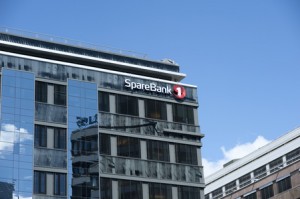SpareBank 1 reopens Nordic euro covereds at tight levels
Aug 23rd, 2012
SpareBank 1 Boligkreditt sold a Eu1bn five and a half year deal on Monday as covered bond issuers this week took advantage of spreads on core paper tightening towards pre-crisis levels.
 The Norwegian deal was launched on Monday morning shortly after an Eu2bn eight year ING Bank covered bond, and followed a Eu750m issue for Italy’s UniCredit last Tuesday that was the first benchmark euro covered bond in three weeks.
The Norwegian deal was launched on Monday morning shortly after an Eu2bn eight year ING Bank covered bond, and followed a Eu750m issue for Italy’s UniCredit last Tuesday that was the first benchmark euro covered bond in three weeks.
“We prepared the deal during the summer and we have had everything lined up from early August,” said Arve Austestad, chief executive at SpareBank 1 Boligkreditt. “We were waiting to see if the investors were back and got the impression from all the senior deals last week that this was the case, with UniCredit confirming that.
“We were therefore pleased to be able to come out on Monday — even if we opted to wait a little because of ING.”
Having taken over Eu1bn of indications of interest at initial price thoughts of the mid-swaps plus 20bp area, leads BNP Paribas, DZ Bank, HSBC and UniCredit opened books with guidance of 17bp-19bp over. With Eu1.7bn of orders in the book, the guidance was revised to 17bp, and demand totalled Eu1.9bn when the books were closed. The Eu1bn size was what SpareBank 1 had set out to raise.
“We opted for Eu1bn as that is our expected need for the second half of the year in euros,” said Austestad. “The Eu1bn limit is why the process was so carefully managed, with the spread being fixed and the books closed quite quickly.”
Some 80 accounts were involved in the transaction, with Germans taking 52%, the Nordics 21%, the UK 12%, France 5%, Switzerland 5%, Austria 2%, the Benelux 1%, and others 2%. Banks were allocated 48%, fund managers 29%, insurance companies and pension funds 10%, central banks and other official institutions 8%, private banks 3%, and corporates 2%.
The deal came inside where outstanding SpareBank 1 paper was seen in the secondary market, but Austestad said that it is difficult to say just where the market is.
“There is some quotation of our bonds in the secondary market but the question of what is fair value is still open,” he said. “I understand that even if there is a strong bid for Nordic paper, there are not much flows.”
Market participants have been pointing out how spreads versus swaps are returning to levels not seen since before the collapse of Lehman Brothers. However, Austestad said that even at today’s tighter pricing euro levels are not as compelling as they might seem.
“There seems to be something of an imbalance between demand and supply,” he said. “But for us, even at these spreads approaching pre-2008 levels euro funding is not so advantageous for us compared with domestic levels.
“The cost of the cross-currency swap is still expensive and that remains the one thing that is key to Nordic supply.”
He said that the euro benchmark will give the issuer an all-in cost of around Nibor plus 55bp-60bp, while an admittedly smaller, Nkr1bn (Eu) seven year issue it launched two weeks ago came at 66bp over.
Despite the tight pricing in the context of euros, SpareBank 1’s new issue traded well in the aftermarket.
“It has traded in the area of around asset swaps plus 17bp/14bp since pricing,” said Gavin Jackson, covered bond trader at
Crédit Agricole CIB, “with initial additional buying flow giving way to a few small profit-takers. The Nordic sector in general remains very well bid, but with several accounts now eyeing further supply and taking the opportunity to move out of rich sub-asset swap two year paper.”
A Eu1bn 10 year senior Svenska Handelsbanken deal launched last Thursday (16 August) also remained well bid.
“I was asked whether it is worrying that a week later it is trading ‘only’ a couple of basis points inside re-offer,” said Christina Moschou, investment grade credit trader at Crédit Agricole CIB. “My view is that pricing was spot on — investors absorbed Eu1bn of paper and I have been selling some paper to real money on secondary since then.
“There was not enough scope for immediate tightening, but assuming the overall market does not suffer, this issue will slowly go tighter on the back of an eventual lack of supply.”
SpareBank 1, meanwhile, could be present in dollars later this year.
“We always plan to do one to two dollar issues per year and we may look at dollars in the fourth quarter,” said Austestad.








